Franciacorta sparkling wine comes from Lombardy, with DOCG status produced from grapes grown within the area of Franciacorta, south hills of Lake Iseo, in the Italian Province of Brescia. It was awarded DOC status in 1967, the designation then also including red and white still wines. Since 1995 the DOCG classification has applied exclusively to the sparkling wines of the area.
Grapes for Franciacorta are grown in strictly delimited vineyards in the communes of Adro, Capriolo, Cazzago San Martino, Cellatica, Coccaglio, Cologne, Corte Franca, Erbusco, Gussago, Iseo, Monticelli Brusati, Ome, Paderno Franciacorta, Paratico, Passirano, Provaglio d’Iseo, Rodengo Saiano, Rovato and Brescia, with soil conditions described as mineral-rich, granular-sized, calcareous gravel and sandy morainal soils that cover a limestone bedrock.
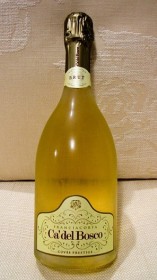 The DOCG declared vineyards extend 2,200hectares (5,400 acrres) and the distribution of permitted grape varieties are 85% Chardonnay, 10% Pinot nero and 5% Pinot bianco.
The DOCG declared vineyards extend 2,200hectares (5,400 acrres) and the distribution of permitted grape varieties are 85% Chardonnay, 10% Pinot nero and 5% Pinot bianco.
Nonvintage Franciacorta (NV) may not be released until at least 25 months after harvest, of which 18 months must be in contact with the yeast in the bottle (compared to 15 months in the case of Champagne). Franciacorta Vintage or Millesimato may not be sold until at least 37 months after harvest, of which 30 months must be in contact with the yeast (similar to Champagne). A Franciacorta rosé must contain at least 15% Pinot nero, and may be made by blending red wine. Franciacorta Satèn must be a Blanc de blancs with only the use of Chardonnay and/or Pinot bianco permitted, with only 4.5 atmospheres of pressure instead of 6.
Recently our friend and wine guru Gary Chevsky participated in a tasting event and these are his thoughts:
“On the heels of a great Champagne tasting this weekend at Santana Row’s Vintage Wine Merchants, I was itching for more sparkles. Kudos to Vintage for putting together an excellent line-up of Champagnes for a meager $40 ($25 for members) – they certainly packed the shop, and the punters were not disappointed.
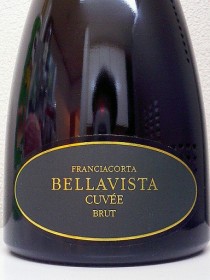 This was the first time I had the 1999 Dom Perignon, and it was probably my fave Dom P, showing the classical well-developed nuttiness. Compared to it, the just released 2002 was too young and simple at this stage. Other notables were the always reliable and incredibly inexpensive Hiedsieck & Co “Blue Top” ($25-30), the elegant Delamotte ($35, Salon’s little sibling), and the well-regarded higher-end Champagnes by Pol Roger (Reserve), Egly-Ouriet (Brut Tradition Grand Cru), and Gosset (Brut Grand Reserve).
This was the first time I had the 1999 Dom Perignon, and it was probably my fave Dom P, showing the classical well-developed nuttiness. Compared to it, the just released 2002 was too young and simple at this stage. Other notables were the always reliable and incredibly inexpensive Hiedsieck & Co “Blue Top” ($25-30), the elegant Delamotte ($35, Salon’s little sibling), and the well-regarded higher-end Champagnes by Pol Roger (Reserve), Egly-Ouriet (Brut Tradition Grand Cru), and Gosset (Brut Grand Reserve).
That was Sunday. On Monday, my faith in Champagne re-affirmed, it was now Italy’s turn to impress.
I am a big fan of Franciacorta. Italy’s answer to Champagne, it can be every bit as profound. Made in the traditional method (aka Champagne method) where the second fermentation and ageing on the lees take place in bottle, Franciacorta can evolve beautifully over many years, especially vintage examples, and can also be enjoyed young. Last night my wine/tennis group had a re-union (after I tore my achilles tendon earlier this year) at our local de-facto standard seafood hole-in-the-wall – the legendary Old Port Lobster Shack in Redwood City. To grease the wheels, we brought two of the most highly regarded Franciacorta producers – Bellavista and Ca’del Bosco. And the good news – Franciacorta, although being unknown in the non-wine circles, is readily available in this country. I got mine from WineChateau.com (Bellavista and Ca’del Bosco). Seafood, fries and sparkling wine – how can you go wrong with that combo?!
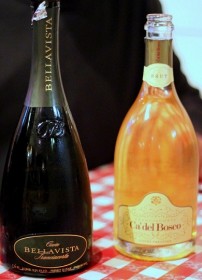 We didn’t. The Lobster Shack’s naked lobster roll is fabulous, and their beer-battered fish and chips are out of this world. But the dish that both Franciacortas really shone with was steamed mussels – petite, tender, flavorful in a great broth begging for dipped bread. Eric suggested that the wine really brought out the minerally tones in the mussels. I thought it went well even with the creamy New England clam chowder – another not-to-be-missed beauty from the Shack.
We didn’t. The Lobster Shack’s naked lobster roll is fabulous, and their beer-battered fish and chips are out of this world. But the dish that both Franciacortas really shone with was steamed mussels – petite, tender, flavorful in a great broth begging for dipped bread. Eric suggested that the wine really brought out the minerally tones in the mussels. I thought it went well even with the creamy New England clam chowder – another not-to-be-missed beauty from the Shack.
I gotta say – on a relatively quiet Monday night, we spent three hours chilling at this characterful joint. The folks there, especially the hostess Shay, are so friendly, she reminded me of my mom. Everyone had a great time, and with tongues un-tied, we reminisced of the old tennis follies and the crazy things that happen in the wine circles.
Bellavista is an old classic Franciacorta producer, and their non-vintage cuvee was a more serious expression than Ca’del Bosco’s floral and lemony entry level cuvee “Prestige” – an all-time dependable friend, that I always keep stocked in my cellar. Just for the heck of it, we followed with beers, and agreed that Franciacorta was a better, lighter, more elegant match. Enjoy!”
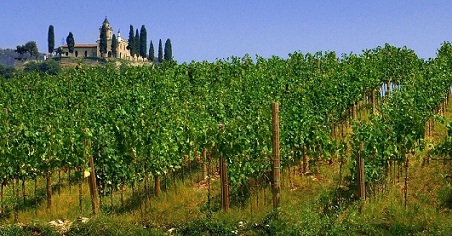
I would like to welcome Gary Chevsky, TorreBarolo’s new guest blogger. Gary is WSET-certified and has been blogging for the past three years. He hails from the San Francisco area so many of his posts are about Californian wines, though lucky for me he has a particular passion for wines from the Langhe and Roero region. His wine reviews are informative without being jargon heavy but more importantly he is a man that gets the big picture……to enjoy life and sees the pleasure of a fine wine as one element that contributes to a memorable occasions with friends and family….or as he puts it “This blog is not about wine, but about life – life made better by wine”. I am particularly happy to host Gary’s blog posts as being pregnant these past many months has obviously had an impact on my ability to share my wine suggestions so it is nice to leave all the heavy (glass) lifting to Gary. 
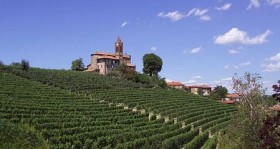 “The other day I had dinner with MariaCristina Oddero – the owner of the Oddero winery, one of the top producers of Barolo, well respected for their dependable quality, and notable for being run by a female in traditionally a male-dominated business. MariaCristina took over from her father Giacomo Oddero in the mid 1990’s, making subtle improvements upon his methods, and according to her, coaxing more complexity from the grapes. Now at 82, Giacomo cannot deny her success, but back then he was not at all supportive.
“The other day I had dinner with MariaCristina Oddero – the owner of the Oddero winery, one of the top producers of Barolo, well respected for their dependable quality, and notable for being run by a female in traditionally a male-dominated business. MariaCristina took over from her father Giacomo Oddero in the mid 1990’s, making subtle improvements upon his methods, and according to her, coaxing more complexity from the grapes. Now at 82, Giacomo cannot deny her success, but back then he was not at all supportive.
They’ve been making wine for 6 generations. The first ever Oddero Barolo was bottled in 1878. A traditionalist, maintaining age-old techniques as exemplified in the modest use of oak (big Slavonian oak barrels) and long maceration times, combined with modern-day equipment and cleanliness, Oddero’s perfume and fruit manage to shine through strong tannic structure at a relatively young age (5 years+).
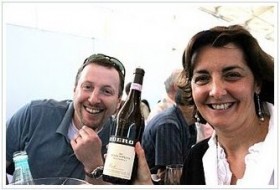 At the dinner hosted at Donato Enoteca, we sampled an array in the most perfect setting imaginable, with great food and good company, without being overwhelmed by multitude of wines or time pressure and fatigue of a trade tasting. A flawless custom-crafted Piedmontese 6-course meal by Donato accompanied 6 wines – a Chardonnay/Riesling blend Langhe Bianco Collaretto 2008, Barbera d’Asti Vinchio 2006, basic Barolo 2005, single-vineyard Barolo Rocche di Castiglione 2005, single-vineyard Barolo Bussia Soprana Vigna Mondoca 2004, finishing off with Moscato d’Asti Cascina Fiori 2008. After the official meal was over, Eric the wine director pulled out Barbaresco Gallina 2005 and Oddero Villero 2005. Under the spell of food and company, the wines served at perfect temperature in perfect glassware to a crowd in damn good mood showed very well indeed, reaffirming the appeal of the 2005 vintage (see my notes from Tre Bicchieri tasting earlier this year).
At the dinner hosted at Donato Enoteca, we sampled an array in the most perfect setting imaginable, with great food and good company, without being overwhelmed by multitude of wines or time pressure and fatigue of a trade tasting. A flawless custom-crafted Piedmontese 6-course meal by Donato accompanied 6 wines – a Chardonnay/Riesling blend Langhe Bianco Collaretto 2008, Barbera d’Asti Vinchio 2006, basic Barolo 2005, single-vineyard Barolo Rocche di Castiglione 2005, single-vineyard Barolo Bussia Soprana Vigna Mondoca 2004, finishing off with Moscato d’Asti Cascina Fiori 2008. After the official meal was over, Eric the wine director pulled out Barbaresco Gallina 2005 and Oddero Villero 2005. Under the spell of food and company, the wines served at perfect temperature in perfect glassware to a crowd in damn good mood showed very well indeed, reaffirming the appeal of the 2005 vintage (see my notes from Tre Bicchieri tasting earlier this year).
The lowly Barbera and Moscato d’Asti were very very good too. As for the Barolos, the wines were solid. The basic 2005 had a fascinating hint of salami on the nose – on special that night for $34 (6-pack pricing), I thought it was the best value. The Rocche was promising, but quite tannic at this point. The Bussia Soprana Vigna Mondoca was a year older (2004), more intense, more open and dark-fruity, while the impressively deep-flavored Villero displayed hints of coffee. I was told that the 2000 Vigna Rionda available for sale ($110) was amazing – supposedly a significant step up from the mid-tier and worth the high price tag, but alas it was not tasted that night.
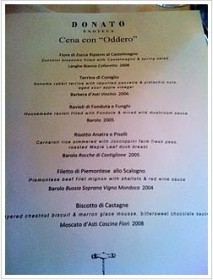 The next day as I attended the Wine Warehouse trade event in San Francisco’s Fort Mason focusing on the new (2006) releases of Barolos, I ran into Mariacristina again. This time I drank her array of 2006’s – the basic Barolo, then Rocche di Castiglione, and finally the Villero. I also re-tasted the 2004 Vigna Mondoca. Oddero’s 2006’s were noticeably more open and less bitter-tannic than all other 2006 Barolos I’d tasted all year, including those from Parusso, Canterno Fantino, Einaudi, and Marcarini. Across the board they have been tough for me to judge due to incredible, hard-as-nails, gum-drying tannins in these young Nebbiolos, although talking to a number of experienced tasters and winemakers themselves, the message has been that 2006 is significantly better vintage than 2005 and more classic than 2004 (2004 shows more fruit while 2006 has more acid, earth, spice and tannin for even longer development). Considering how good the 2004 was, it’s a bold statement for 2006, but at this point I will just have to take their word for it – I could not tell, and will stay away from 2006’s for at least another year until they mellow out somewhat.
The next day as I attended the Wine Warehouse trade event in San Francisco’s Fort Mason focusing on the new (2006) releases of Barolos, I ran into Mariacristina again. This time I drank her array of 2006’s – the basic Barolo, then Rocche di Castiglione, and finally the Villero. I also re-tasted the 2004 Vigna Mondoca. Oddero’s 2006’s were noticeably more open and less bitter-tannic than all other 2006 Barolos I’d tasted all year, including those from Parusso, Canterno Fantino, Einaudi, and Marcarini. Across the board they have been tough for me to judge due to incredible, hard-as-nails, gum-drying tannins in these young Nebbiolos, although talking to a number of experienced tasters and winemakers themselves, the message has been that 2006 is significantly better vintage than 2005 and more classic than 2004 (2004 shows more fruit while 2006 has more acid, earth, spice and tannin for even longer development). Considering how good the 2004 was, it’s a bold statement for 2006, but at this point I will just have to take their word for it – I could not tell, and will stay away from 2006’s for at least another year until they mellow out somewhat.
Interestingly, the 2004 Vigna Mondoca was not as tasty as the day before. Blame it on the setting, on palate fatigue, on the bottle temperature, or lack of decanting, or the glassware…. whatever the reason, this was a telling lesson of how one should be circumspect of the hurried trade tasting impressions. Be mindful of the circumstances in which critics’ scores are given, remember how important the context and setting in which are you consuming wine is, and don’t jump to conclusions too quickly.

 The DOCG declared vineyards extend 2,200hectares (5,400 acrres) and the distribution of permitted grape varieties are 85% Chardonnay, 10% Pinot nero and 5% Pinot bianco.
The DOCG declared vineyards extend 2,200hectares (5,400 acrres) and the distribution of permitted grape varieties are 85% Chardonnay, 10% Pinot nero and 5% Pinot bianco. This was the first time I had the 1999 Dom Perignon, and it was probably my fave Dom P, showing the classical well-developed nuttiness. Compared to it, the just released 2002 was too young and simple at this stage. Other notables were the always reliable and incredibly inexpensive Hiedsieck & Co “Blue Top” ($25-30), the elegant Delamotte ($35, Salon’s little sibling), and the well-regarded higher-end Champagnes by Pol Roger (Reserve), Egly-Ouriet (Brut Tradition Grand Cru), and Gosset (Brut Grand Reserve).
This was the first time I had the 1999 Dom Perignon, and it was probably my fave Dom P, showing the classical well-developed nuttiness. Compared to it, the just released 2002 was too young and simple at this stage. Other notables were the always reliable and incredibly inexpensive Hiedsieck & Co “Blue Top” ($25-30), the elegant Delamotte ($35, Salon’s little sibling), and the well-regarded higher-end Champagnes by Pol Roger (Reserve), Egly-Ouriet (Brut Tradition Grand Cru), and Gosset (Brut Grand Reserve). We didn’t. The Lobster Shack’s naked lobster roll is fabulous, and their beer-battered fish and chips are out of this world. But the dish that both Franciacortas really shone with was steamed mussels – petite, tender, flavorful in a great broth begging for dipped bread. Eric suggested that the wine really brought out the minerally tones in the mussels. I thought it went well even with the creamy New England clam chowder – another not-to-be-missed beauty from the Shack.
We didn’t. The Lobster Shack’s naked lobster roll is fabulous, and their beer-battered fish and chips are out of this world. But the dish that both Franciacortas really shone with was steamed mussels – petite, tender, flavorful in a great broth begging for dipped bread. Eric suggested that the wine really brought out the minerally tones in the mussels. I thought it went well even with the creamy New England clam chowder – another not-to-be-missed beauty from the Shack.
 “The other day I had dinner with
“The other day I had dinner with  At the dinner hosted at
At the dinner hosted at  The next day as I attended the Wine Warehouse trade event in San Francisco’s Fort Mason focusing on the new (2006) releases of Barolos, I ran into Mariacristina again. This time I drank her array of 2006’s – the basic Barolo, then Rocche di Castiglione, and finally the Villero. I also re-tasted the 2004 Vigna Mondoca. Oddero’s 2006’s were noticeably more open and less bitter-tannic than all other 2006 Barolos I’d tasted all year, including those from Parusso, Canterno Fantino, Einaudi, and Marcarini. Across the board they have been tough for me to judge due to incredible, hard-as-nails, gum-drying tannins in these young Nebbiolos, although talking to a number of experienced tasters and winemakers themselves, the message has been that 2006 is significantly better vintage than 2005 and more classic than 2004 (2004 shows more fruit while 2006 has more acid, earth, spice and tannin for even longer development). Considering how good the 2004 was, it’s a bold statement for 2006, but at this point I will just have to take their word for it – I could not tell, and will stay away from 2006’s for at least another year until they mellow out somewhat.
The next day as I attended the Wine Warehouse trade event in San Francisco’s Fort Mason focusing on the new (2006) releases of Barolos, I ran into Mariacristina again. This time I drank her array of 2006’s – the basic Barolo, then Rocche di Castiglione, and finally the Villero. I also re-tasted the 2004 Vigna Mondoca. Oddero’s 2006’s were noticeably more open and less bitter-tannic than all other 2006 Barolos I’d tasted all year, including those from Parusso, Canterno Fantino, Einaudi, and Marcarini. Across the board they have been tough for me to judge due to incredible, hard-as-nails, gum-drying tannins in these young Nebbiolos, although talking to a number of experienced tasters and winemakers themselves, the message has been that 2006 is significantly better vintage than 2005 and more classic than 2004 (2004 shows more fruit while 2006 has more acid, earth, spice and tannin for even longer development). Considering how good the 2004 was, it’s a bold statement for 2006, but at this point I will just have to take their word for it – I could not tell, and will stay away from 2006’s for at least another year until they mellow out somewhat.









